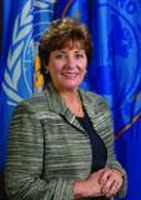Thursday, April 25, 2024
News and Views from the Global South
WORLD HEALTH DAY: Climate Change a Challenge to Human Species
Interview with Mirta Roses* - Tierramérica
- World Health Day, celebrated Apr. 7, is a good opportunity to "call attention to the fact that the survival of humanity is at stake" because of climate change, according to Mirta Roses, director of the Pan-American Health Organisation.
TIERRAMERICA: What are the principal health threats that climate change poses in Latin America?
MIRTA ROSES: One of the most well-known, a result of changes in the usual patterns of temperature, atmospheric pressure, humidity, etc., occurs in the distribution of diseases, as well as vectors, which generally are insects. These also modify, for example, the seasonal cycles that had prevented the dissemination of diseases. So new ones appear or others expand, such as respiratory illnesses, yellow fever, malaria or dengue, which now extends across the continent.
Climate change gives way to a higher frequency of phenomena like hurricanes and periods of drought followed by excessive rains, which especially affect the most vulnerable, the communities that live in high-risk zones and in poverty.
TA: What concrete measures is PAHO taking?
MR: We are trying to promote individual and community measures to combat the factors that contribute to climate change. Health is a high energy consumption sector, through hospitals and other services, which is why we have to help bring about better management of the means, techniques and patterns of consumption. We are also working on improved disposal of hazardous medical waste.
TA: How are these recommendations turned into concrete measures? MR: To lead by example, we are developing a plan that we call "Green PAHO", to learn on the basis of habit and institutional culture, and from the organisation's workers. But our usual work is with the health ministries, and that is how we expand awareness about a more sustainable way of life. We already have experience with the smoking habit: we began at home, declaring PAHO a smoke-free space, and then we convinced governments.
We are taking action on managing health services and, of course, with closely related areas like water management, sanitation and waste treatment. We are cooperating with countries on early warning systems and contingency plans, not only to confront the effects of climate change and the increase in natural disasters, but also with respect to availability of potable water and food.
TA: How is PAHO taking up the usually neglected problem of sanitation?
MR: In the Americas there are about 150 million people who don't have access to safe water and some 130 million without basic sanitation. In this International Year of Sanitation we are highlighting the excluded population. The region experienced this in a very painful way in 1991 when cholera reemerged, and it had an impact on people and on economic development, because water-borne diseases lead to health barriers in trade.
TA: What influence does PAHO have in obtaining financing for extending sewage systems?
MR: It has been important to demonstrate the evidence. We have had to become experts in order to produce economic impact statements, show how these are related to nutrition, infant and maternal mortality, and development. We have come up with many instruments for analysis, sectoral studies to identify needs, and investment plans, and thus win attention from development banks to assist with costly infrastructure projects.
On the other hand, a lot of work has been done to improve management of water and sewage utilities, and in training human resources.
TA: What is the response to such actions at the municipal and community levels?
MR: For nearly 20 years we have been carrying out the Healthy Municipality plan, which encompasses health promotion and disease reduction with an eye to local development and reinforcing the authorities and inter-sectoral action focused on political leaders, neighbourhood councils, etc. In most cases it begins precisely with the demands for access to water and sanitation. Also with great sensitivity to the development of simplified technology appropriate to local cultures.
We have had a great deal of support from, and have worked closely with, indigenous groups, who have their own conceptions about a harmonious relationship with nature and the exploitation of natural resources.
TA: Tell us about one of those experiences.
MR: We work continuously with indigenous peoples in the Andes and in Paraguay, with the recovery and strengthening of simple technology and investment in community systems for prospecting for water and for disinfecting water for household use. This has helped control cholera, which in 10 years was once again eliminated in the region. Traditional practices have been renewed, like water councils for administration and for maintaining a balance between domestic and agricultural use.
(*Dario Montero is deputy regional editor for IPS Latin America. Originally published by Latin American newspapers that are part of the Tierramérica network. Tierramérica is a specialised news service produced by IPS with the backing of the United Nations Development Programme and the United Nations Environment Programme.)

 Print
Print




